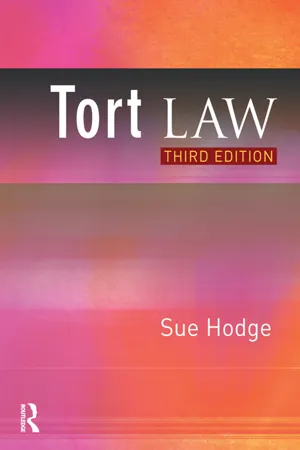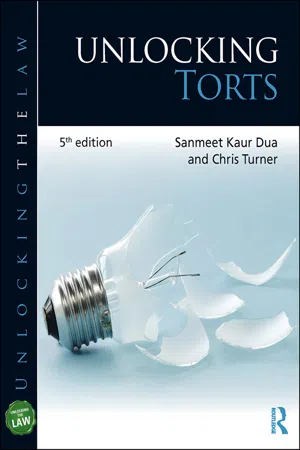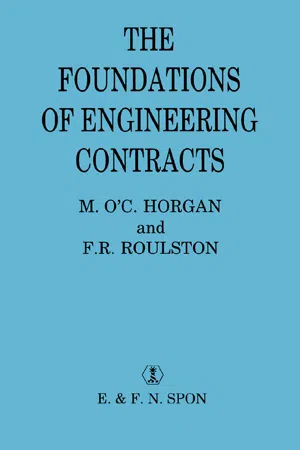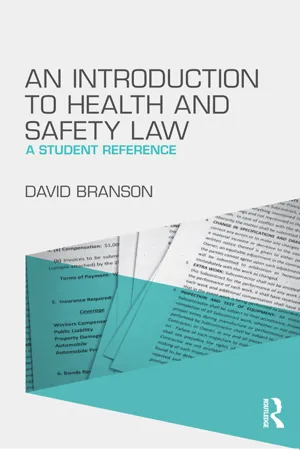Law
Occupiers Liability Act 1984
The Occupiers Liability Act 1984 is a UK law that sets out the duty of care owed by occupiers of premises to visitors. It distinguishes between lawful visitors, such as invited guests, and trespassers, and outlines the responsibilities of occupiers towards each category. The Act aims to ensure that occupiers take reasonable steps to protect the safety of those who enter their premises.
Written by Perlego with AI-assistance
Related key terms
11 Key excerpts on "Occupiers Liability Act 1984"
- eBook - ePub
- Timon Hughes-Davies, Nathan Tamblyn(Authors)
- 2019(Publication Date)
- Routledge(Publisher)
Chapter 11Occupiers’ Liability
This chapter discusses the duty of occupiers to take reasonable care of visitors under the Occupiers’ Liability Act 1957, and of non-visitors under the Occupiers’ Liability Act 1984.If someone trips over a loose tile on the floor of a hotel lobby, can they sue for their injury? What if that person was trespassing? This chapter is about the duty of care owed by occupiers of ‘premises’ (typically land or buildings) to other people on those premises. The duty of care owed to visitors is governed by the Occupiers’ Liability Act 1957. The duty of care owed to non-visitors (usually trespassers) is governed by the Occupiers’ Liability Act 1984.This chapter proceeds as follows. First, we shall consider some themes and concepts common to both Acts. Second, we shall discuss the duty of care owed to visitors. Third, we discuss the duty of care owed to non-visitors. Finally, we shall explore some common defences.____________As you read
- Identify the differences between the regimes of the 1957 Act and the 1984 Act.
- Identify the common ground shared by the two Acts.
- Be aware of how the facts might give rise to other causes of action in tort besides occupiers’ liability.
- Consider whether the law strikes a fair balance between the duties imposed on an occupier and the person injured on their premises.
11.1 Common themes
In this section, we explore how occupiers’ liability is concerned with the condition of the premises, rather than activities performed on those premises. Then we turn to consider concepts (like ‘occupier’ and ‘premises’) common to both the 1957 Act and the 1984 Act.Liability for condition of premises
Although there remains some academic discussion of the point, the case law seems to suggest that occupiers’ liability is concerned only with the condition of the premises, that is, whether the premises themselves are safe or not. It is not concerned with the occupier’s activities on the premises.1 - 7 Occupiers’ Liability INTRODUCTIONOccupiers’ liability is a specialised branch of the tort of negligence and is tested in most examinations year after year. The area is governed by statute – namely, theChecklistOccupiers’ Liability Act 1957and theOccupiers’ Liability Act 1984. Thus, in addition to the common law concepts of duty, breach, causation and remoteness, attention must be paid to the statutes and the particular sections that elaborate on the common law principles. Be aware that in moving around a premises, a person may well change in status from a visitor to a non-visitor – and therefore being at first subject to the1957 Actto being subject to the1984 Act. By doing so, it will be much more difficult for that person to demonstrate that they are owed a duty of care, and this difference should be brought out in answers. This chapter has three problem questions and one essay question. Many students find occupiers’ liability challenging insofar as questions can involve many issues, so it is important to be wise with timing, focus on the critical issues and have a sound grasp of the statutes to assist with your structure.(a) the definitions of occupiers, visitors and non-visitors; (b) the duty regarding children and skilled persons, independent contractors as well as the legal effect of warnings; (c) the exclusion of duty; (d) the circumstances under which a duty to a non-visitor arises and the nature of this duty as distinct from a duty to visitors.Students must be familiar with the following areas:Aim HigherStrong candidates show a grasp of all the relevant features that comprise occupiers’ liability including ‘premises’ and ‘occupier’ but without dwelling on these where they are not relevant. You must concisely apply the relevant provisions of the statute. Also, most tort students will have a statute book that is accessible to them in the exam, so it will serve little purpose to copy out entire and lengthy sections as this will not receive much credit and it will also waste time. Better candidates will paraphrase the key section or even better to simply refer to sections and apply them on the facts without over describing the section. In addition Tomlinson v Congleton
- eBook - ePub
- Wendy Laws(Author)
- 2021(Publication Date)
- Routledge(Publisher)
This chapter first explains the limited duty of care owed by an occupier to such persons. It notes the conditions that must be satisfied before such duty can arise. Then it explains the limited scope of the duty once it has arisen.It considers the standard of care the occupier is expected to meet when a duty does arise. It notes that the usual principles for causation of damage apply. Finally, it outlines possible defences.14.2 Liability to trespassers – introductionAs explained in Chapter 13 , we will use the terms ‘visitor’ and ‘trespasser’ to distinguish between the two classes of people covered by the Occupiers’ Liability Act 1957 and Occupiers’ Liability Act 1984 (‘the 1957 Act’ and ‘the 1984 Act’).11 As noted in Chapter 13, the 1984 Act also covers some classes of people who are not trespassers (e.g., those exercising a private right of way).As a reminder, a visitor (owed a duty under the 1957 Act) is a person who is invited or permitted by the occupier to be on the premises. In contrast, people may enter premises as trespassers in a wide range of circumstances. Look at these problem scenarios:An uninvited guest gate-crashes a party at a house and is injured when he falls downstairs. At a zoo, a young child wanders away from her parents and enters an area which is closed to the public, where she is injured when she falls through some railings. A teenager cannot afford to buy a ticket to enter a theme park, so he sneaks in without paying but is injured when he falls from a defective carriage on one of the rides.In each of these cases the person who is hurt is a trespasser on the premises. (In the case of the child, she becomes a trespasser when she wanders into an area where she had no right or permission to enter.) So, in cases like this, the question of the occupier’s duty is governed by the 1984 Act.
The 1984 Act says that an occupier is defined in the same way as for the 1957 Act. So, we know that an occupier is the person who exercises control over the premises.14.3 Occupiers and premises - 4 Negligence and dangerous premises The Occupiers’ Liability Acts 1957 and 1984Although the problems posed by dangerous premises are addressed in this chapter, it is important to bear in mind that many of the matters already discussed will be relevant to this. We will come back to this point later.The essence of the problem connected with dangerous premises is to identify those persons to whom a duty of care is owed, the person who owes that duty and the extent of the duty. This chapter starts by considering the distinction between lawful and unlawful visitors and discussing the identity of the person who owes the duty. It will go on to discuss the nature of the duty owed to particular categories of visitors.Lawful and unlawful visitorsUntil recently the occupier of land and premises could escape liability for negligent injury caused to someone on that land or in those premises by establishing that the person had no right to be there. This is an example of the maxim discussed under the heading ‘Participation in an unlawful act (ex turpi causa non oritur actio)’ in Chapter 5 (see pp. 106 –107 ). A person classified as a trespasser was historically given no protection.Problems could arise in respect of lawful visitors as the duty of care owed by an occupier varied according to the nature of the permission which allowed the person to enter the land. Parliament acted, following the recommendations of the Third Report of the Law Reform Committee (Cmd 9305) 1954, which dealt with some of these problems, and then passed the Occupiers’ Liability Act 1957.The Act ensures that any visitor with either express or implied permission or lawful authority to be on the land has the benefit of the protection of the Act. It is not difficult to identify such categories of visitors. Persons who have received a specific invitation are obviously included as are those who have paid for the right of entry, for example to a theme park or to a cinema. Others included are those who visit premises as a result of implied permission, for example a person delivering milk which has been ordered or a person delivering the post, or the fire brigade summoned to deal with a fire emergency. Lawful authority will extend to the police and other persons exercising rights granted by a warrant.
- eBook - ePub
- Keith Owens(Author)
- 2013(Publication Date)
- Routledge-Cavendish(Publisher)
Cutler v United Dairies (1933), a runaway horse had run into a field. The plaintiff tried to calm it and was injured. It was held that the plaintiff could not claim to be a rescuer since there was no immediate danger requiring a rescue.OCCUPIERS’ LIABILITY ACTS 1957 AND 1984
If a person is injured as a result of premises being unsafe or an unsafe activity being carried out on the premises, he or she may have one of three legal actions. We have already considered the actions of breach of statutory duty and the tort of negligence. The third possibility is under the Occupiers’ Liability Act 1957. This provides that occupiers of premises owe a duty to visitors to take such care as is reasonable in order to see that the visitor will be reasonably safe in using the premises. The later Act, passed in 1984, deals mainly with the thorny question of trespassers.Relationship between negligence and occupiers’ liability
In theory, the Occupiers’ Liability Act creates a duty in relation to the state of the premises. Thus, the occupier is liable for any injury arising from the defective state of the premises. Negligence creates a duty to take care in relation to activities carried out on the premises. However, in practice the courts do not always make this distinction. Perhaps, in any case, the distinction in many cases will be academic, since it seems that the duty laid down by the Act and the duty laid down by the tort of negligence are so similar in effect as to produce similar outcomes.Definition of ‘premises’
The Act defines ‘premises’ in such a way as to include ‘any fixed or moveable structure including any vessel, vehicle or aircraft’. Thus ‘premises’ includes not only land and buildings upon the land but also appliances or objects on the land of which the visitor has been invited or allowed to make use, for example, grandstands, theatre stages, diving-boards, ladders, etc.Who is an occupier?
The duty is owed by an occupier of premises. This is not necessarily the owner. Thus, if property is rented, the duty will normally be owed by the tenant. This, however, depends on the circumstances of the case. If two or more persons have control over premises, they may all be occupiers. In Wheat v Lacon (1966), the owner of a public house allowed the manager to take in paying guests on the upper floor. An accident occurred whereby a guest was injured when slipping on an unlighted staircase leading to the upper floor. The question arose as to whether the pub owners were also occupiers. Held: - eBook - ePub
- Brendan Greene(Author)
- 2017(Publication Date)
- Routledge(Publisher)
1984 , were passed to clarify the law and to set out detailed rules. These rules are in effect statutory negligence.At common law the entrants to land were divided into four categories which were created inAddie & Sons v Dumbreck [1929]AC 358 as set out in the table below. The duty owed became progressively less until it came to trespassers when the duty was merely not to harm them. Although the categories are still relevant the duties owed have been changed by the Occupiers’ Liability Acts .Contractual visitor Occupier has a material interest in their visit. Duty to see that the premises are safe, e.g. a paying customer at a swimming pool Invitee Duty to prevent damage from an unusual danger, e.g. a customer in a shop is owed this duty Licensee Duty to protect from any concealed danger the occupier knows of, e.g. asking a friend to your house Trespasser Duty not to intentionally or recklessly harm, e.g. someone climbs over your garden wall The common law rules are still relevant as s1 Occupiers’ Liability Act 1957 (OLA 1957 ) provides that visitors are those who were invitees or licensees at common law. The OLA 1957 also includes contractual visitors under s5(1). All these three categories are now ‘visitors’ and owed the common duty of care under s2(1) OLA 1957 . Trespassers are now covered by the OLA 1984 .If an entrant to land falls outside the rules of both Occupiers’ Liability Acts then the common law rules apply to them. InBritish Railways Board v Herrington - eBook - ePub
- Sanmeet Kaur Dua, Chris Turner(Authors)
- 2019(Publication Date)
- Routledge(Publisher)
Chapter 10 ), or there may in any case be an action in negligence available.Liability for land and premises falls into two distinct areas:Occupiers’ liability is a fairly recent tort and is found in two statutes:■ Liability by an occupier of premises for loss or injury caused by the state of the premises – such liability can also be divided according to whom has suffered the loss or injury.■ Liability by a person other than an occupier of land for defects in the premises themselves – this involves landlords and builders.■ the Occupiers’ Liability Act 1957 – which is concerned with the duty of care owed to all lawful visitors; and■ the Occupiers’ Liability Act 1984 – which is concerned with the duty owed to people other than lawful visitors, the major group here being trespassers.Both areas then are statutory in form, but certainly in the case of occupiers’ liability have developed out of negligence. As a result much of the terminology and many of the principles are the same or similar to basic negligence principles. Indeed, though the Acts do contain extensive definition, where definitions are not supplied in the Acts these are to be found in the common law.trespasser A person who enters premises without permission or who exceeds the permission they are givenInevitably there is some overlap with negligence. The basic liability arises from the loss or injury caused by the ‘state of the premises’. Loss or damage that arises other than because of the state of the premises then should be claimed for under negligence where this is possible. - eBook - ePub
- Jonathan S. Kitchen(Author)
- 2017(Publication Date)
- Routledge(Publisher)
The second concession is the proviso contained in section 11 (3) that the action permitted by section 11 (2) is ‘without prejudice to any action which lies apart from the provisions of this Act’. The two possible options relevant here are discussed below.IV. OCCUPIERS’ LIABILITY
As section 6 (2) of the Mineral Workings (Offshore Installations) Act specifies that the regulations made for the safety, health and welfare of persons on offshore installations may have effect as respects persons ‘whether or not present in the course of their employment’, the fact that there might even occasionally be present on board persons who are not employees of the owner or operator makes it necessary to consider the duty owed to such persons in case an accident should happen to one of them. In such a case the duty owed by an occupier of premises to his visitor is of great importance.The provisions of the Occupiers’ Liability Act, 1957, have effect: ‘…in place of the rules of the common law, to regulate the duty which an occupier of premises owes to his visitors in respect of dangers due to the state of the premises or to things done or omitted to be done on them’.58As section 3 of the Continental Shelf Act, as extended, brings questions arising out of acts or omissions within the jurisdiction of the courts of the United Kingdom it would appear that following the arguments of Chapter 2 - eBook - ePub
- F R Roulston **Decd**, M.O'C. Horgan, F.R. Roulston(Authors)
- 2003(Publication Date)
- Routledge(Publisher)
The latest word on this is probably the Latent Damage Act 1986 to which reference should be made.For any action resulting in a claim for damages: 3 years from the date when a cause of action first occurs. This period can be extended when the available knowledge at the last date is inadequate to further the claim.8.7 OCCUPIER'S LIABILITY TO VISITORS TO SITE
Every occupier of a premises has a duty to safeguard third-parties visiting the premises, and the Employer is no exception. He exercises his duty through his project manager, who is therefore personally responsible to his client for the safety of visitors on-site. Note that the duty is expected from the occupier, not the owner, the lessee, the absent landlord, or such like, but the person who is occupying the site. If any accident occurs by which a third-party is injured, the occupier can be jointly charged along with the people who actually caused the injury or damage. The charge is negligence, in that the necessary precautions weren’t taken to ensure the third party’s safety. A contractor, his employees and his visitors, observers, callers, etc., are all treated as third parties, and none of them is likely to be the occupier.Therefore, in arranging a contract, the project manager should see that it contains a clause which indemnifies the Employer from all costs, damages and charges which he may sustain from claims made against him by any visitor or employee on the site to the extent that the Employer was not guilty of actually subscribing to the damage the third party sustained. The exclusion cannot, of course, remove from the Employer’s staff on the site any direct blame they might incur through their own actions, but it can relieve the Employer from a claim made against him, as occupier of the site, when he has been blameless for the actual accident producing the casualty.How is an occupier defined? He is the person who controls the premises, and especially the access of visitors and other entrants. He is the person who can say: ‘Shut that gate and keep them out’, or ‘Open it up and let them in’. He need not be the owner, who might be miles away, having handed control over to the project manager. The occupier owes his same common duty of care to all persons he allows to enter, and hence can include his contractors, their staff and employees among his ‘visitors’. - eBook - ePub
- Chris Monaghan(Author)
- 2015(Publication Date)
- Routledge(Publisher)
South Hetton Coal Company Ltd v North-Eastern News Association Ltd [1894] 1 QB 133, a company was able to recover damages where its reputation was injured by the defendant’s libel. Libel refers to written statements and slander to oral statements that injure the claimant’s reputation. Section 1(1) of the Defamation Act 2013 states ‘A statement is not defamatory unless its publication has caused or is likely to cause serious harm to the reputation of the claimant’. Importantly, s.1(2) requires a business to establish that the published statement ‘is likely to cause the body serious financial loss’. There are a number of defences available to the defendant, including the truth (s.2) and honest opinion (s.3).OCCUPIERS’ LIABILITYImagine that TSH Ltd own the freehold of its warehouse in Southampton and lease an office in Rochester. TSH Ltd would be the occupier of both premises and would be liable under the Occupiers’ Liability Act 1957 to all visitors to its property. In Wheat v E Lacon & Co Ltd [1966] AC 552, the House of Lords provided a definition of who was an occupier. Lord Denning held that an occupier, ‘was simply a convenient word to denote a person who had a sufficient degree of control over premises to put him under a duty of care towards those who came lawfully onto the premises’ (p. 577). Therefore, as TSH Ltd would have a sufficient degree of control over both premises it would be regarded as an occupier. The duty imposed by the Act is that of the ‘common law duty of care’ (s.2(1)). The extent of the duty owed depends on age of the visitors and special risks that visitors such as tradesmen would guard against (s.2(3)). The Occupiers Liability Act 1984 extends the liability of the occupier to include people who enter onto the occupier’s land without permission.PASSING OFFKey definition: Passing offA tort designed to protect the goodwill or reputation in goods that are manufactured or services that are provided by a business.The tort of passing off protects the intellectual property in a business’s name and the products it manufacturers. In Reckitt & Colman Products Ltd v Borden Inc (No 3) [1990] 1 WLR 491 Lord Oliver reiterated the requirements required for there to be an actionable passing off. The claimant is required to first, ‘establish a goodwill or reputation attached to the goods or services which he supplies in the mind of the purchasing public’. This requires that the claimant prove that the product’s distinctive feature generates goodwill, which equates to profits. Second, the claimant must ‘demonstrate a misrepresentation by the defendant to the public (whether or not intentional) leading or likely to lead the public to believe that goods or services offered by him are the goods or services of the plaintiff’. A substantial number of the public must be confused and believe that the goods offered by the defendant are associated with those offered by the claimant. In United Biscuits (UK) Ltd v Asda Stores Ltd - eBook - ePub
An Introduction to Health and Safety Law
A Student Reference
- David Branson(Author)
- 2014(Publication Date)
- Routledge(Publisher)
Consumer Protection Act 1987.Liability for the Tort of NegligenceNowadays, the main area of liability for the employer is under the common law Tort of Negligence. This area of law developed in the late nineteenth century as a means of providing a remedy to employees injured at work, who were unable to sue in contract. At first the tortuous remedy was limited by the doctrine of ‘common employment’, which held that an employer was not liable to his employees for the torts of other employees, a principle upheld in Priestley v Fowler (1838). However, the courts later began to counter this by developing the concept of a primary duty of care being placed on the employer, as well as limiting the defence of volenti or consent in situations of employment. As a result, in Smith v Baker & Sons (1891), an employer was held liable to his employee who was injured by a falling rock in a quarry, and this case began the development of legal liability in this area.A further problem was the defence of contributory negligence, which originally would deny remedy to a party if he was in any way liable for the accident. However, the Law Reform (Contributory Negligence) Act 1945 replaced the complete defence with a partial defence, which meant a reduction of damages for the claimant if he was partly liable. From this time on, the employee would only have to prove the existence of a duty of care, the breach of that duty and the fact that his injury arose as a consequence of the breach in order to establish tortuous liability on the part of the defendant. These are the three key elements of the Tort of Negligence, which I will consider below.The duty of careThe basic elements of the duty of care in health and safety owed to employees were those laid down in the leading case of Wilsons & Clyde Coal Ltd v English (1938). This case involved a serious injury in a mine, caused by moving plant, which was in collision with the employee. The case established that the duty of care was personal to the employer and could not be delegated to another employee. The duty of care was owed to a person acting in the course of employment and was not strict, but qualified by what was ‘reasonably foreseeable’. The duty of care as established here was fourfold: to provide; safe plant and equipment, a safe place of work, competent fellow employees and a safe system of work. These duties have been extended in subsequent cases to include a duty to provide adequate supervision and the duty to provide a safe working environment. It may be noted that these duties provided the basis for the statutory duties in Criminal Law to be found in Section 2(2) of the Health and Safety at Work etc. Act 1974 (HSWA)
Learn about this page
Index pages curate the most relevant extracts from our library of academic textbooks. They’ve been created using an in-house natural language model (NLM), each adding context and meaning to key research topics.










